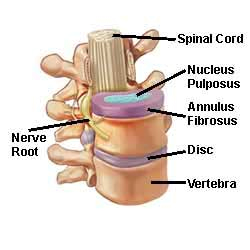Herniation of the nucleus pulposus occurs when the nucleus pulposus (gel-like inner substance) breaks through the anulus fibrosus (tire-like outer structure) of an intervertebral disc (spinal shock absorber). See the image below to see these parts of the intervertebral disc pointed out.
Your back, or spine, is made up of many parts. Your backbone, also called your vertebral column, provides support and protection. It consists of 33 vertebrae (bones). The intervertebral discs are between each of the vertebra. Together, the vertebrae and the discs provide a protective tunnel (the spinal canal) to house the spinal cord and spinal nerves. These nerves run down the center of the vertebrae and exit to various parts of the body.Your back also has muscles, ligaments, tendons, and blood vessels. Muscles are strands of tissues that act as the source of power for movement. Ligaments are the strong, flexible bands of fibrous tissue that link the bones together, and tendons connect muscles to bones and discs. Blood vessels provide nourishment. These parts all work together to help you move about.
A herniated disc occurs most often in the lumbar region of the spine especially at the L4-L5 and L5-S1 levels (L = Lumbar, S = Sacral). This is because the lumbar spine carries most of the body’s weight. People between the ages of 30 and 50 appear to be vulnerable because the elasticity and water content of the nucleus decreases with age.
The progression to an actual herniated disc varies from slow to sudden onset of symptoms. There are 4 stages:
Stages 1 and 2 are referred to as incomplete, where 3 and 4 are complete disc herniations. Pain resulting from a herniated disc may be combined with a radiculopathy, which means neurological deficit. The deficit may include sensory changes (ie, tingling, numbness) and/or motor changes (ie, weakness, reflex loss). These changes are caused by nerve compression created by pressure from interior disc material.

The extremities affected are dependent upon the vertebral level at which the herniated disc occurred. Consider the following examples: